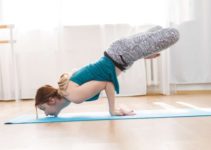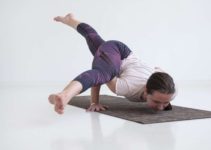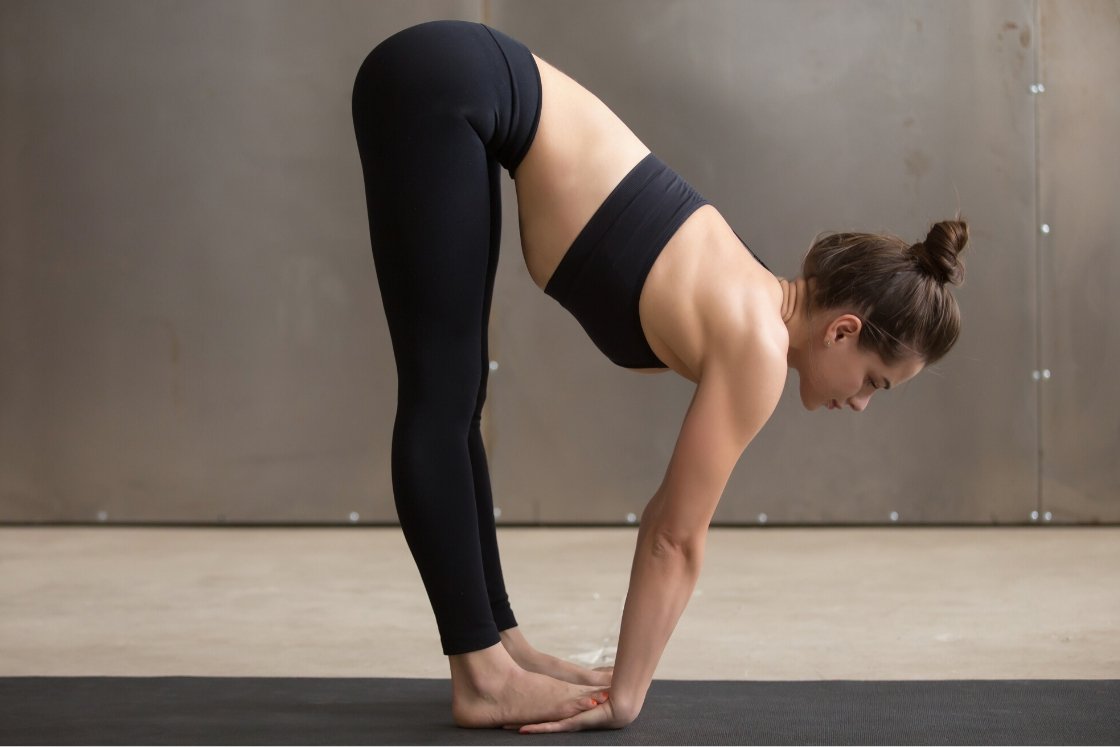
Padahastasana is a standing forward bend pose. Physically, it provides a deep stretch to the hamstring, hip, and neck muscles. Mentally, after practicing this pose you will realize better coordination between the mind and body.
In Surya Namaskar, this pose comes at the 3rd and 10th step of twelve poses sequence. In the 3rd step of Surya Namaskar, Padahastasana shows the blessing of the sun god while on the 10th step, it represents to bow before the nurturer of all lives on earth i.e. Sun.
One can be become as flexible as a rubber by enrolling Padahastasana in their schedule. This will light up a ray of mental and physical serenity if practiced every day.
Yoga is a light, once lit, will never dim. The better your practice, the brighter the flame.
–B.K.S lyengar
Padahastasana Meaning
In Padahsatasana, Pada means ‘feet’ and hasta means ‘hand’. Padahastasana is called ‘Hand to feet pose’ or ‘Hand under feet pose’. Due to the positioning of the palm under the feet in this pose, Padahastasana gets its identity.
Padahastasana is also known by different derived names around its variant pose Uttanasana. Gorilla pose is one of the specific names of Padahastasana.
The call for the hand to go under feet needs the flexibility of one’s ‘will’ to accomplished the posture before they acclimatized their body into a stretch. Therefore, Padahastasana acting as a bridge to cross the river of stiffness restraining an individual to find their supple foundation in life.
Padahastasana Practice Guide
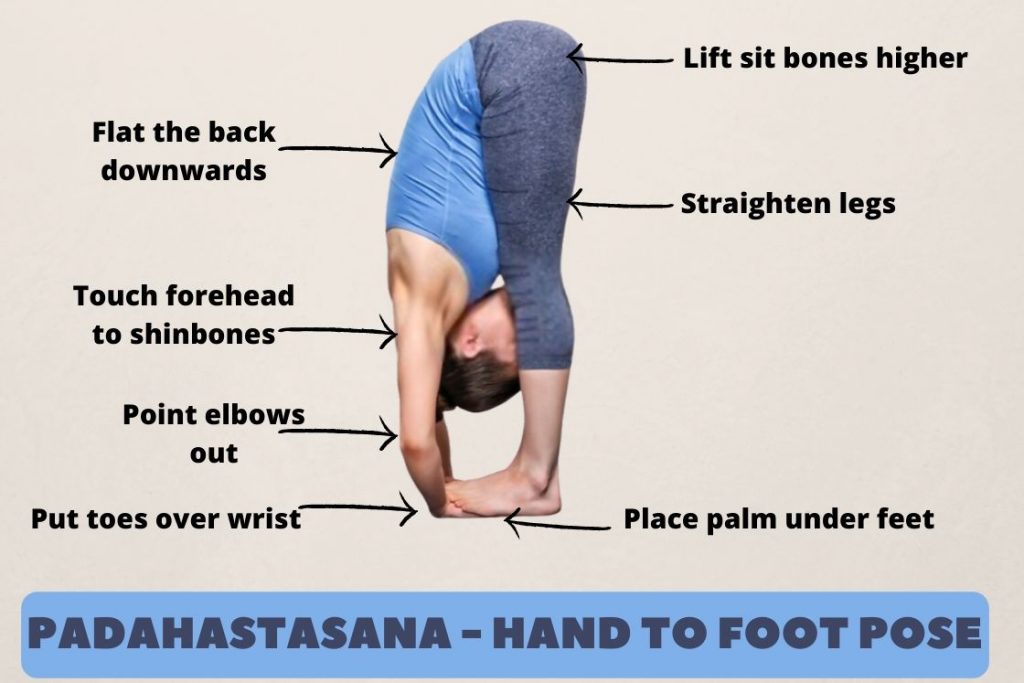
Follow the points below to safely practice Padahastasana:
Precautions & Contraindications
- People with Osteoporosis might unfit for this yoga asana practice. Specifically in older people, because their bones are susceptible to fracture. In the case of Padahastasana, it could be spine and hips.
- People with the condition of high blood pressure should go slowly in this asana, under an expert teacher. Jerking torso down can raise breathing, which in turn increases heart rate.
- Sciatica (pain in the sciatic nerve), slip disk (a rubbery disc between the spinal bones), Hernia, and any kind of spinal injury people should refrain from doing Padahastasana.
Preparatory Pose
- Tree Pose (Vrikshasana)
- Downward facing dog (Adho Mukha Svanasana)
- Seated Forward Bend (Paschimottanasana)
Padahastasana Steps
- Begin by coming into the Tadasana (mountain pose). Keep your back straight.
- Your feet should be at hip distance apart to stabilize the foundation of posture. Arms along the side of the body and relax.
- Now, inhale and raise your arms up above the head. by maintaining the concavity of your back, come down while exhaling to the feet.
- Further, bring your torso in the proximity to the knees and try to touch your shin bone by chin or nose. Do not lay pressure to do this, listen to your body here.
- Lift your feet to insert your palms under the soles. Find the balance here and maintain it for a few long breaths.
Release
- After being in the pose for about 20 to 30 seconds, now slowly come up by raising your trunk up to half-forward bend position.
- Lift your heels and slide your hands out.
Then, hands can be on the shin bone and on side of the hips to balance the returning process. Makes sure that your back is in a straight line with the head. Now, slowly back into Tadasana.
Tips for the Beginners
It would be difficult for the beginners to reach the extremities of the posture but going easy and slowly to attain the flexibility is not a herculean task.
- In the case of people unable to touch the floor or feet, opting strap to add an extra hand could be helpful. But do not overstrain. One can also go for shin bone, to begin with.
- Beginners can bend their knees to go into the asana as it might be tough to bend forward with straight knees or lacking flexibleness.
Time and Duration
Padahastasana can be practiced for 20 to 30 seconds initially. However, one can increase the time period as per their ease to remain in the posture, respectively.
It is a sequential pose of the Surya namaskara so, the ideal timing to practice this asana is early morning.
One should practice this asana on empty stomach in the morning and after 4 to 5 hours after a meal as it lays pressure on the abdomen.
Props and Modifications
Prop & Modification can be used as an assisting partner to practice Padahastasana.
- A strap can be helpful in proceeding with the posture. People with stiffened back, belly fat, etc can use it while coming down to the foot. It can be grabbed as a support to keep one bend as long as they can bear.
- Holding calf could also be one of the remedies to ascertain the pose for some time. However, reaching to feet should be the aim of practitioners.
Follow Up Pose
- Triangle Pose ( Trikonasana)
- Chair Pose (Utkatasana)
- Warrior Pose (Virbhadrasana)
Padahastasana Variations
Padhastasana can be easily practiced by introducing a slight variation in the basic posture. Few such implementations can be seen in the following asanas.
1. Uttanasana – Intense Forward Bend

Padashastasana is the variation of Uttanasana which can be practiced for the same or vice-versa.
- In this variation, the practitioner can grab their calf, ankle from the back and can also touch the floor while resting arms over thighs, if the reach is good.
Unlike, Padahastasana in this asana you can take your hands wherever to experience a deep stretch.
2. Padangusthasana – Big Toe Pose
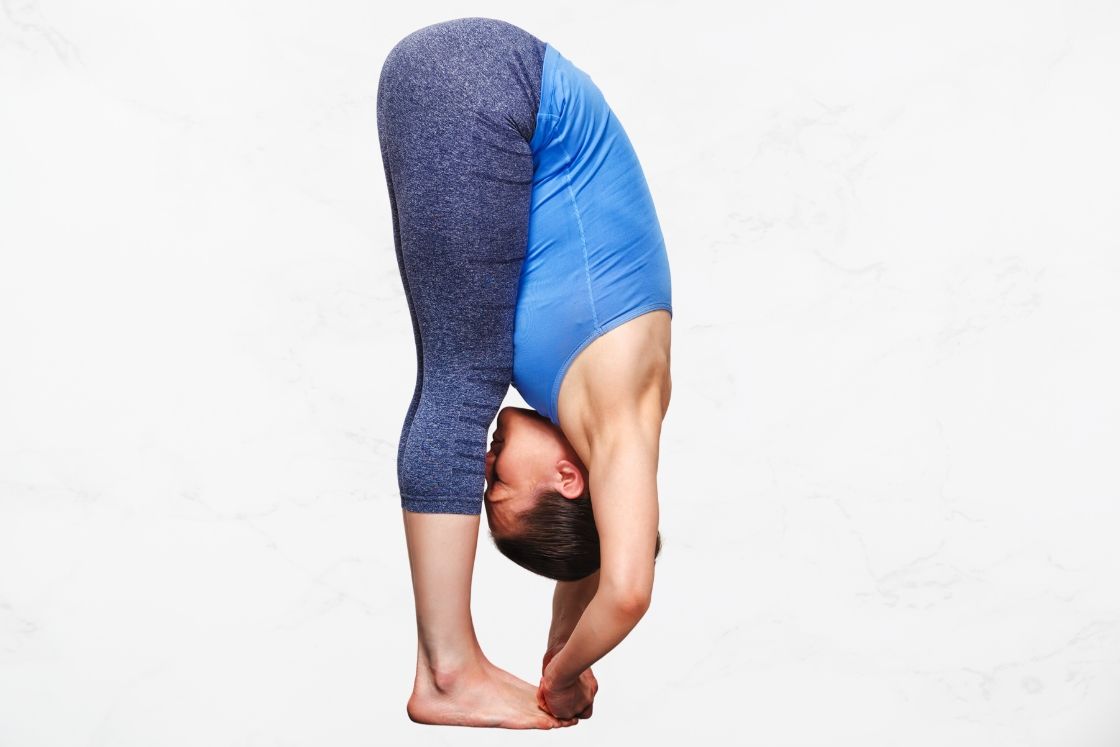
Begin this variation by coming into the Tadasana and then slowly come down to the feet make sure your back and head remain in a straight line.
By engaging your quadriceps balance the posture. Insert middle and index finger in between the big and small toe. Try to set an inward curve in the back while in the pose.
Now, lift your torso away from the thigh and remain in the posture for few breaths and then come back gradually.
Padahastasna Benefits
- Regular practice of this asana trains the Parasympathetic nervous system, which is also called a counter stress response system. One of the studies [efn_note] Impact of Yoga Practices on Occupational Stress among Indian Army Personnel http://indianyoga.org/wp-content/uploads/2016/03/v5-issue2-article4.pdf [/efn_note] has concluded that regular yoga practice along with Padahastasna has positive effects on the management of stress and anxiety.
- This yoga asana practice is one of the best regards to burning off the extra belly weight and combat obesity [efn_note] Yogic Intervention and the Weight Loss http://indianyoga.org/wp-content/uploads/2013/07/v3-issue2-article12.pdf [/efn_note]. Forward bending if persist regular results in oxidation of fat, which leads to shedding some weight.
- It increases the range of movability of joints like knee, pelvic, and sacroiliac (link your pelvis and lower spine). It also enhances the flexibility [efn_note] The effect of selected yogic practices upon flexibility and agility of soccer players http://www.theyogicjournal.com/pdf/2019/vol4issue2/PartD/4-2-93-881.pdf [/efn_note] of muscles like a calf, hamstring, thighs, hips, and shoulders, etc.
- Forward bending in Padhastasana rushes the oxygen-rich blood to the scalp, which ensures its nutritional sufficiency. Therefore, it helps in hair growth and reduces hair fall as well.
- This asana has a massaging effect over the abdominal region including the digestive system, which re-energize the digestive organs. Padahastasna also enhances the metabolism to secrete the optimum amount of digestive secretion. Therefore, improves digestion and overcome indigestion.
- According to one of the research [efn_note] Role of yoga in attention, concentration, and memory of medical students http://njppp.com/fulltext/28-1531306776.pdf [/efn_note], daily practice of some yoga practices including Padhastasna helps in improving memory, concentration, attention, etc.
- This asana promotes the calmness in the mind and lightness in the body as it frees up the tightness of muscles. One can achieve a profound state of mental serenity by regular practice.
- Padhastasna is one of the sequences of the Surya Namaskar series, which on practice stimulates the endocrine system [efn_note] Effect of Regular Yogic Training on Growth Hormone and Dehydroepiandrosterone Sulfate as an Endocrine Marker of Aging https://www.hindawi.com/journals/ecam/2014/240581/ [/efn_note] to promote the secretion of Growth hormone (GH) and dehydroepiandrosterone sulfate (DHEAS). Therefore, promote slow aging.
